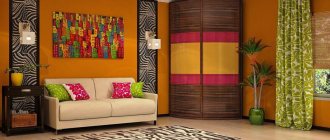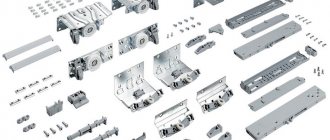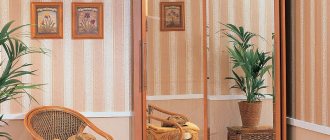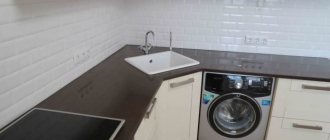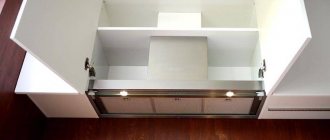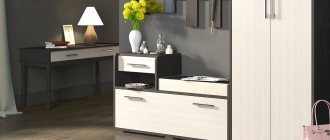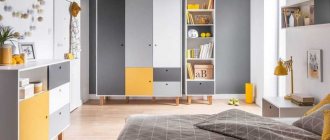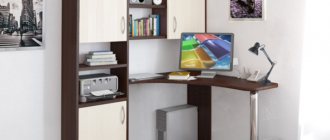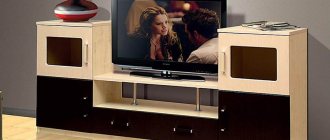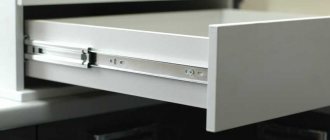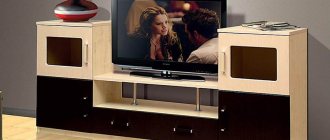<
>
It is difficult to imagine a kitchen design without cabinets for storing food, cutlery and other household utensils. The interior of one of the most important rooms in the house should inspire the creation of culinary masterpieces, be comfortable, functional and aesthetically attractive.
Kitchen cabinets in the interior - types and purpose
In post-Soviet times, a kitchen set was a standard set of furniture; today, the range of cabinets present on the furniture market offers a variety of stylistic and design solutions.
When choosing furniture, you should first of all be guided by the size of the room. The basic rule for choosing storage systems for a small kitchen is rational use of space. You should not overload the room with unnecessary pieces of furniture.
To make your kitchen look more attractive and interesting, use cabinets of different heights in your interior.
According to their purpose, kitchen cabinets can be divided into several main types:
- privates with regiments;
- storage systems for built-in equipment;
- drying cabinets.
Primary requirements
The purpose of the kitchen set is to store and place culinary utensils in free access for household members. Usually it consists of several cabinets of diverse designs in the same design style. The modules together represent an integral composition, but each of them plays its own role.
The following requirements apply to kitchen cabinets:
- environmental friendliness of manufacturing materials;
- possibility of installation and placement of household appliances;
- the presence of shelves and accessories for storing food and utensils;
- compliance with the overall design of the room.
There are many options for configurations, dimensions, and designs of kitchen cabinets. It is necessary to plan the set based on the preferences of the apartment residents. Fans of gatherings with friends will need a minibar and open sideboards for services.
True cooks cannot do without spacious cabinets for storing pots and baking dishes. Perfectionists will certainly appreciate furniture in the minimalist style.
Types of kitchen cabinet designs
To organize a functional and comfortable space in kitchen equipment, different types of kitchen cabinets are used:
- mounted;
- floor;
- corner;
- cabinets.
Each type has its own functional purpose and design features.
Wall mounted kitchen cabinets
Wall-mounted models are located in the top row of the kitchen unit. The key purpose of furniture is to store utensils and food preparations; extractor hood cabinets can be classified as a separate category. Wall-mounted storage systems are characterized by compact dimensions and relatively low weight.
The main structural elements of the hinged module are the frame, internal filling, and facade. Based on the design features, wall kitchen cabinets are divided into the following types:
- closed;
- open;
- combined.
Products of the first type are a standard cabinet with doors and shelves. In open systems there is no front part; the piece of furniture is often used to store decorative elements and jars of spices. Combined models combine elements of closed and open cabinets.
Above the sink, as a rule, there is a cabinet with a drying rack. The main difference of this wall-mounted module is the presence of a rack for drying cups, plates and a tray for collecting drainage water.
Floor row of kitchen cabinets
Floor modules are one- or two-door cabinets installed on the floor under the countertop. Floor-standing models are much more massive and spacious than the upper modules.
The lower row cabinets are used for storing massive household items (pots, kettles, pans) and built-in appliances. In addition, the floor modules act as a support for the kitchen countertop.
In addition to standard cabinets equipped with shelves and drawers, a cabinet under the sink is installed in the bottom row of the kitchen unit. The piece of furniture is used to hide utilities (sewerage, water supply pipelines, filters for water purification, metering devices), and storage of waste collection containers. Structurally, the sink cabinet is a hollow cabinet without a back wall.
Corner models
Corner cabinets are used for L-shaped kitchen layouts. The piece of furniture makes it possible to make the most efficient use of the free corners of a small room, and is characterized by large capacity and compact dimensions.
Based on location and design features, there are several types of corner cabinets:
- mounted;
- sink cabinets;
- cabinets.
Kitchen pencil cases
A pencil case is a piece of furniture that combines the functions of the upper and lower row modules. The main difference between a pencil case is the height of the storage module; as a rule, a column cabinet occupies the entire space from floor to ceiling. Based on the number of sections, pencil cases are divided into single- or multi-door models.
The functional purpose of furniture depends on its design features. Pencil cases with rich internal equipment are used to store a large amount of food, cutlery and other kitchen utensils. A refrigerator is hidden behind the façade of a hollow high cabinet.
Combined type pencil cases are especially popular. In the upper and lower parts of the column there are systems for storing utensils and products, the middle hollow part is used for installing built-in equipment.
Cabinet functions in the kitchen
Cupboards for kitchen utensils solve a number of problems that many people face:
- First of all, they perform a storage function. Those who love to cook and have large families often have a lot of dishes that have nowhere to be stored. Not only dishes are stored in cabinets, but also products that can be stored in cabinets (cereals, dry seasonings), household chemicals, kitchen utensils, textiles, and more.
- Organization of space - for convenience and order, it is important that everything has its place. So, thanks to cabinets and neat placement of items, the kitchen will be able to avoid clutter, crowding and find comfort. You shouldn’t try to fit all the dishes into a small cabinet, this will only create confusion; you need to be smart about placing items.
- Cabinets are not only functional, but also beautiful. Good furniture can make a room a wonderful, stylish place where you can spend your time pleasantly.
- When placed correctly, cabinets can hide design flaws and highlight advantages. For example, long, tall cabinets can visually increase the height of a room.
- It is possible to integrate appliances into kitchen cabinets: microwave, range hood, TV, oven and others.
Standard sizes of kitchen cabinets
The standard depth of kitchen wall cabinets ranges from 30 to 43 cm. The height of the wall units can reach 36, 72 or 96 cm. The width of the top row modules varies in the range of 15-80 cm.
Floor storage modules have a depth of about 50-60 cm. The standard height of cabinets is 85 cm. Typical width of the elements of the bottom row (in centimeters):
- 15;
- 30;
- 45;
- 50;
- 60;
- 80
Designers recommend choosing floor cabinets whose depth is slightly less than the width of the countertop. A tabletop slightly overhanging the cabinets looks much more attractive.
Lighting elements
This room should be sufficiently lit at any time of the day.
Since it includes the presence of hanging drawers (on the upper tier), the classic lighting option in this case becomes far from relevant.
In this case, an excellent solution is to install lamps on the bottom of wall cabinets; you can make these yourself. Or you can purchase it from an IKEA factory; in this case, kitchen cabinets can be selected to suit every taste.
For these purposes the following can be used:
- incandescent lamps – characterized by reduced duration of use, increased heating and low power;
- fluorescent lamps – have an even light of optimal power;
- LEDs are an unusual option that can add elements of creativity.
They can be arranged in any shape, and the quantity depends on the individual preferences of the owners and the quality of lighting.
Filling – types of kitchen cabinet storage systems
All the functionality of kitchen furniture is hidden behind its front part, so it is very important to choose kitchen cabinets with well-organized interior space. Roll-out and pull-out storage systems are used to complete kitchen sets.
<
>
The modern furniture market, along with traditional stationary shelves and drawers, offers a huge range of internal contents:
- mesh baskets are U-shaped metal containers that are fixed on the side walls or on the inside of the facade. Often used to fill the empty space of a sink cabinet;
- rotating carousels - an axis installed inside the cabinet on which rotating semicircular shelves are located. The maximum radius of rotation of the shelves around the axis is 2700;
- magic corner - rectangular shelves or drawers connected to each other by rotating elements. The front row of drawers is fixed on the inside of the facade. When the doors are opened, a row of shelves unfolds in sequence;
- bottle holders - specialized narrow shelves equipped with high holders.
Tips for choosing kitchen furniture
When choosing a storage system for the kitchen, it is recommended to choose the right color scheme for the furniture set. It should influence not only the mood of its owners, but also their appetite. Warm shades such as peach, yellow or terracotta perfectly awaken the appetite.
While cool blues, grays or dark greens can overwhelm it. They reduce the kitchen space several times, thereby creating an uncomfortable atmosphere in the food consumption area.
To decorate the interior of a small kitchen, it is recommended to choose light-colored cabinets. For example, light green, beige or light orange. This will help add light to the cooking area and visually enlarge it.
Particular attention should be paid to the “stuffing” of the cabinets. Basically, these are multifunctional storage systems that are located inside. Most often these are metal elements. Multi-level designs allow you to achieve maximum capacity for storing food and small utensils.
Italian cuisines Venetto Classico- Kitchen sets Nolte Kuchen - several reasons to become the owner of such a set
Stylish decoration of kitchen walls
These details will help to arrange all the items in one place and provide easy access to the necessary utensils. The photo of the kitchen cabinet shows popular models of furniture paraphernalia. It is also worth thinking about anti-theft systems from https://uralvision.com/antikrazhnyye-sistemy; this will bring more peace of mind.
Kitchen cabinet opening systems
Kitchen furniture sets differ not only in their internal contents, but also in their opening systems. There are several main types of mechanisms:
- swing;
- lifting;
- retractable
<
>
Swing opening systems are used in the designs of upper and lower row modules. The main mechanism of the system is furniture hinges. In turn, door fittings are divided into the following types:
- overhead, inset or semi-overlay hinges with an opening angle of 95-1100;
- hinges with opening angle 120-1600;
- hinges with built-in motion closers.
Lifting opening mechanisms are designed to equip wall cabinets. The opening system includes special fixing elements that securely hold the doors in a horizontal plane, and closers. To open the door, just lift the edge a little. Lifting systems use spring mechanisms or gas lifts.
The operating principle of the retractable opening system is based on the use of roller or ball guides. Opening systems with partial or full extension are available on the market. The advantage of the former is a more affordable price, the latter are more convenient to use.
Kitchen furnishings
Having moved into a new apartment, a family is faced with the problem of arranging furniture and other accessories in the rooms. After the hallway, the kitchen is a sacred place. Here people cook and eat. It should be especially cozy and comfortable.
Appliances and pieces of furniture must be arranged so that everything is nearby, within walking distance. It's not far from the refrigerator to the stove.
Dining or serving table - 1.5 - 2 meters from the sink. Cabinets and tables can be arranged conveniently from the start. So that you don't have to rearrange it later.
Base and legs
The lower part of the floor cabinets is equipped with legs or a plinth. Cabinet legs can be stationary or adjustable. To protect the lower space from dust, a plinth is used - a decorative strip that is attached to the legs of the kitchen unit.
Based on the material of manufacture, the following types of bases are distinguished:
- aluminum;
- plastic;
- planks made of chipboard or MDF.
You can hide electrical wiring or supply water hoses behind the decorative strip. Often the base is equipped with ventilation grilles, which are mounted near the built-in oven or refrigerator.
Exquisite Design
For convenience when preparing food, kitchen lighting under cabinets began to be used. This lighting allows you to: safely cut vegetables and fruits; be in a comfortable environment while working.
The feeling of mystery in a dimly lit kitchen with soft lighting above the food preparation area creates an upbeat, slightly playful mood. With such a mood, cooking comes easy. This is what exquisite design means.
Photos of kitchen cabinets
<
>
Modern storage systems allow you to modernize limited kitchen space; well-thought-out details maximize the service life, functionality and comfort of the kitchen set.
Photo of a two-level kitchen
Read here Kitchen interior styles: a review of the best 165 photos of modern design
Did you like the article? Share 
Risk of structural collapse
Ceiling cabinets are not only large in size, but also significant in weight, and therefore the risk of the entire structure collapsing increases. To avoid this, it is necessary to use especially strong canopies, and also trust the installation only to highly qualified specialists who can reliably assess the condition of the walls.
Note! You should order furniture exclusively from the factory, since a technologist works there who deals with the safety of the structure and also develops the features of its fastening.
Care should be taken to ensure the strength of the structure to avoid collapse.
What to put in tall cabinets
Tall kitchen cabinets, especially in small spaces, should be easy to open. Therefore, you should carefully consider the choice of opening system, which may be as follows:
- Swing. The usual traditional option. Convenient for small wall cabinets, but requires free space for opening, which is not always practical.
- Lifting. Convenient when the compartment is large or there is a lack of space. For opening, in which the sash either entirely or folded rises to the top, elevator lifts, gas shock absorbers and other special mechanisms are used.
- Sliding. In this case, the door leaves, moving using roller guides, do not occupy any kitchen space. However, access to the internal contents of the compartments is limited.
- No handles. The facade of such a cabinet does not have handles, and the doors open with the touch of a hand. There are mechanical and electrically driven models.
